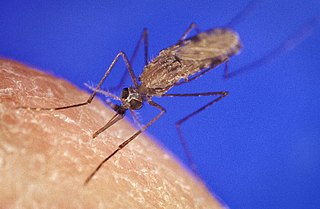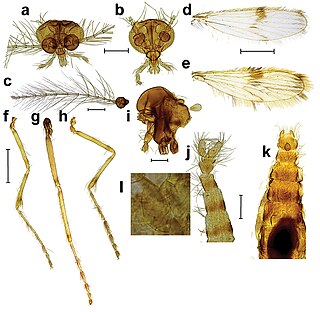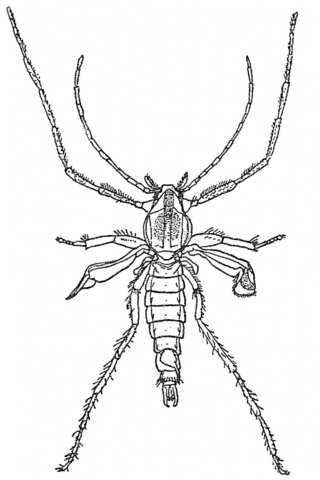Related Research Articles

The Culicomorpha are an infraorder of Nematocera, including mosquitoes, black flies, and several extant and extinct families of insects. They originated 176 million years ago, in the Triassic period. There are phylogenetic patterns that are used to interpret bionomic features such as differences in the nature of blood-feeding by adult females, daytime or nighttime feeding by adult females, and occurrence of immature stages in aquatic habitats.

A midge is any small fly, including species in several families of non-mosquito Nematoceran Diptera. Midges are found on practically every land area outside permanently arid deserts and the frigid zones. Some midges, such as many Phlebotominae and Simuliidae, are vectors of various diseases. Many others play useful roles as prey for insectivores, such as various frogs and swallows. Others are important as detritivores, and form part of various nutrient cycles. The habits of midges vary greatly from species to species, though within any particular family, midges commonly have similar ecological roles.

The Chironomidae comprise a family of nematoceran flies with a global distribution. They are closely related to the Ceratopogonidae, Simuliidae, and Thaumaleidae. Many species superficially resemble mosquitoes, but they lack the wing scales and elongated mouthparts of the Culicidae.

The Chironomoidea are a superfamily within the order Diptera, suborder Nematocera, infraorder Culicomorpha. This superfamily contains the families Chironomidae, Ceratopogonidae, Simuliidae, and Thaumaleidae.
The genus Mesosmittia is cosmopolitan, thus occurring in all biogeographical regions except for Antarctica. Almost nothing or very little is known about its ecology, the larva of one species was described by Strenze (1950) as terrestrial, but adults can be collected using emergence traps set over rivulets.
Abiskomyia is a genus of European non-biting midges in the subfamily Orthocladiinae of the bloodworm family (Chironomidae).
Asheum is a genus of European non-biting midges in the subfamily Chironominae of the bloodworm family Chironomidae. It was originally named Pedionomus by James E. Sublette in 1964; this name was discovered by Patrick Ashe to be preoccupied by PedionomusGould, 1840, so it was renamed to Asheum by both James E. and Mary S. Sublette in 1983, naming it after Patrick Ashe. Asheum is sometimes considered to be a subgenus of Polypedilum.
Apedilum is a genus of non-biting midges of the bloodworm family Chironomidae. The genus was previously considered a junior synonym of Paralauterborniella, but was restored as a separate genus by J. H. Epler (1988) for the species A. elachistus and A. subcinctum.

Corethrella is a genus of midges that are classified in the family Corethrellidae.

Metriocnemus is a genus of non-biting midges in the subfamily Orthocladiinae of the bloodworm family Chironomidae.
Neozavrelia is a genus of non-biting midges in the subfamily Chironominae of the bloodworm family Chironomidae. From the tribe Tanytarsini, There are 23 described species.
Zavrelimyia is a genus of non-biting midges in the subfamily Tanypodinae of the family Chironomidae.
Pentaneurini is a tribe of midges in the non-biting midge family (Chironomidae).
Hudsonimyia is a genus of non-biting midges in the subfamily Tanypodinae of the bloodworm family Chironomidae.

Pontomyia is a genus of flightless marine midges belonging to the subfamily Chironominae in the Chironomidae family. Insects in marine environments are extremely rare while flightlessness, extreme sexual dimorphism, and an extremely short adult life span contribute to making these midges unusual among insects. They are known from the shores of islands in the Indian, Atlantic and Pacific Oceans.

Lygistorrhininae, commonly called long-beaked fungus gnats is a subfamily of flies in the Diptera family Keroplatidae. The groups was long treated as a separate family, but molecular phylogenetic analysis has shown it to belong to Keroplatidae. There are about 7 genera and at least 30 described species in Lygistorrhininae.

Scaptomyza is a genus of vinegar flies, insects in the family Drosophilidae. As of 2022, there are 273 described species of Scaptomyza. Of those, 148 are endemic to the Hawaiian archipelago. This genus is part of the species-rich lineage of Hawaiian Drosophilidae, and is the sister lineage to the endemic Hawaiian Drosophila. The genus Scaptomyza is one of several nested within the paraphyletic genus Drosophila.
Somatia is the sole genus of the acalyptrate brachyceran fly family Somatiidae. The genus includes about seven Neotropical species of small black and yellow flies with a stout and rounded thorax having transverse suture. The legs are separated from the main body by an elongated post-coxal bridge. The broad abdomen is downcurved. The antenna are elbowed with the arista bipectinate. Somatiids resemble members of the Syringogastridae due to the enlarged pronotum and a postcoxal bridge but they have a petiolate abdomen.
2015 in paleoentomology is a list of new fossil insect taxa that were described during the year 2015, as well as other significant discoveries and events related to paleoentomology that were scheduled to occur during the year.
This paleoentomology list records new fossil insect taxa that were described during the year 2014, as well as notes other significant paleoentomology discoveries and events which occurred during that year.
References
- 1 2 Siri, Augusto; Donato, Mariano (2015). "Phylogenetic analysis of the tribe Macropelopiini (Chironomidae: Tanypodinae): adjusting homoplasies" (PDF). Zoological Journal of the Linnean Society . 174: 74–92. doi: 10.1111/zoj.12228 .
- 1 2 Silva, Fabio Laurindo da (2016). "Alotanypus wilhelmensis sp. nov., a new Tanypodinae (Diptera: Chironomidae) from high mountain lakes in Papua New Guinea". Austral Entomology. 55 (4): 360–365. doi:10.1111/aen.12194. S2CID 88575243.
- ↑ Niitsuma, Hiromi (2005). "Taxonomy and Distribution of Alotanypus kuroberobustus comb. nov. (Insecta: Diptera: Chironomidae) from the Palaearctic Region". Species Diversity. 10 (2): 135–144. doi: 10.12782/specdiv.10.135 .
- ↑ Siri, Augusto; Donato, Mariano; Orpella, Germán; Massaferro, Julieta (2011). "Alotanypus vittigera (Edwards) comb. Nov.: Adult redescription, immature description and a phylogenetic analysis of the genus (Diptera: Chironomidae: Tanypodinae)". Zootaxa . 2795: 46–64. doi:10.11646/zootaxa.2795.1.2. hdl: 11336/27738 .